Panasonic Lumix DMC-GX8 Review
Panasonic Lumix DMC-GX8 Introduction
The Panasonic Lumix DMC-GX8 is the new flagship mirrorless from Panasonic. This digital camera introduces an all-new 20 megapixels Four-Thirds sensor which has the highest resolution of any Micro Four-Thirds mirrorless camera. Like the ground-breaking GX7 reviewed here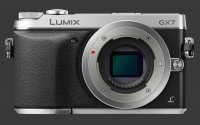
Panasonic Lumix DMC-GX7, the GX8 offers built-in image-stabilization and a large tilting EVF with 0.77X magnification and 100% coverage.
The new sensor is paired with a powerful processor. Together they can capture full-resolution images at 8 FPS or 4K Ultra-HD video. The sensitivity range has been expanded to ISO 100-25600 and shutter-speeds of 1/16000s are now possible. The limit for Bulb exposures has also been pushed to 30 minutes.
The larger redesigned body acquires a deeper grip while losing the built-in flash but is now fully weather-sealed. The Panasonic Lumix DMC-GX8 is aimed at advanced users looking for a capable and efficient camera. It offers plenty of external controls, including dual control-dials.
This new flagship camera is the second Panasonic mirrorless to feature built-in image-stabilization. This allows the GX8 to stabilize legacy lenses and, most importantly, use high-end M.Zuiko lenses designed for Micro Four-Thirds cameras with stabilization.
Its lens mount makes the GX8 compatible with a growing number of Micro Four-Thirds lenses which are often designed for compactness and are now built by several manufacturers.
This digital camera review analyses the usability, image quality and performance of the Panasonic Lumix DMC-GX8.
Panasonic Lumix DMC-GX8 Features
Sensor
- 20 Megapixels CMOS Four-Thirds sensor
- 2X Crop-Factor, 4:3 Aspect-Ratio
- Sensor-Shift image-stabilization
- Micro Four-Thirds lens mount
- Ultra-sonic dust-reduction
Exposure
- ISO 200 - 25600 Standard Sensitivity
- ISO 100 Expanded Sensitivity
- Auto ISO, customizable 400 - 12800 limit
- 1/8000-60s Mechanical Shutter-Speed range
- 1/16000-1s Electronic Shutter-Speed range
- Bulb exposure, maximum 30 minutes
- PASM Exposure modes with Program-Shift
- Multi-Segment, Center-Weighed and Spot metering
- Exposure-Compensation, ±3, 1/3 EV increments
- AEB, 3 - 7 frames, 1/3 - 1 EV increments
Image Parameters
- Automatic, 5 presetsSunny, Cloudy, Shade, Tungsten, Flash, Kelvin and 4 Custom White-Balance settings
- White-balance fine-tuning along 2 axis in 19 steps
- WB Bracketing, 3 frames, 2 step sizes, 2 axis
- Adjustable contrast, sharpness, saturation and noise-reduction, 11 steps each
- 5 Color and 1 B&W modes
- sRGB or Adobe RGB color spaces
Drive
- Continuous Drive, 8 FPS without preview, 5.5 FPS with preview, Unlimited JPEG or 30 RAW
- 4K Ultra-HD Continuous Drive, 30 FPS with optional pre-buffering
- Self-timer, 2s, 10s or 3 shots @ 10 seconds
- Optional Shutter-Delay, Off or 1-8 seconds
- Time-Lapse, 1-9999 frames, 1s to 100m interval, immediate or delayed start
- Stop Motion Animation, Manual or 1-60s interval
- Automatic HDR from AEB at 1 - 3 EV increments
- Optional Auto Align for HDR capture
- Multiple-Exposure, 3 frames
- Optional Auto Gain for Multiple-Exposure
Focus
- Single-shot autofocus (AF-S), continuous autofocus (AF-C) or manual-focus (MF)
- Pinpoint, Single-Area, Custom Multi-Area, 49-Area, Subject Tracking and Face(Eye)-Detect Contrast-Detect AF
- Optional Quick-Shift autofocus
- Optional MF-Assist
- Optional AF-Assist lamp
- Optional Focus-Peaking, 2 levels, 5 colors
Display & Viewfinder
- 0.44" Tilting EVF, 2.4 MP with Eye-Start sensor
- 0.77X Magnification, 100% Coverage
- 3" Rotating touchscreen LCD, 1 megapixel
- Optional Live-View in Manual mode
- Optional Live-Histogram
- Optional guidelines, 3 types
- Optional blinking highlight
- Optional zebra pattern, 2 levels or customizable
- Adjustable Brightness, Contrast and Saturation, 13 steps each
- Adjustable Tint, 21 steps, red and blue axis
Output Processing
- 4:3 Native aspect ratio
- 3:2, 16:9 & 1:1 cropped aspect ratios
- 20, 10 and 5 Megapixels mode
- JPEG, RAW, RAW+JPEG capture
- 2 JPEG Compression qualities
- Adjustable Tone-Curve, 11 levels, for shadows and highlights
- 3 Tone-Curve memories
- Optional Long-Shutter Noise-Reduction
- Optional Diffraction Correction
- Optional Vignetting Correction
- Optional Contrast Enhancement, 3 levels
- Optional Resolution Enhancement, 4 levels
- Optional Face-Recognition
Video
- 4K Ultra-HD @ 30 FPS with MPEG-4 codec
- 1080p @ 60 FPS, 720p & VGA @ 30 FPS with MPEG-4 codec
- 1080p & 720p @ 60 FPS with AVCHD codec
- Built-in stereo microphone
- Audio-input gain, 4 steps
- Audio-meters, 2 channels
- Optional Wind-Filter, 2 levels
Connectivity
- 4K Ultra-HD HDMI output
- USB 2.0 connectivity
- WiFi (802.11b/g/n)
- NFC-F (ISO/IEC 18092)
Misc
- Dual control-dials
- Traditional mode-dial
- Exposure-Compensation dial
- Combined AE-L/AF-L button
- 8 Customizable buttons
- Depth-of-field preview
- Lithium-Ion battery
- SDXC memory
Panasonic Lumix DMC-GX8 Capability - What can it do?
The Panasonic Lumix DMC-GX8 is a professional grade digital camera and is among the most advanced mirrorless on the market. As the second Panasonic to offer built-in stabilization, the GX8 can capture images in low-light with non-stabilized Micro Four-Thirds lenses. It cleverly takes this one step further than its predecessor by combining sensor-shift stabilization and optical image stabilization when available.
Lenses strongly influence the suitability of a camera. Native Micro Four-Thirds lenses are more numerous than those for other mirrorless systems. Additionally, as a derivative of the Four-Thirds mount, most lenses for that mount can be used via an adapter on the GX8 with full functionality, including autofocus.
Manufacturers currently offer Micro Four-Thirds lenses covering a focal-range of 7 to 300mm, equivalent to 14 - 600mm. This goes from an extremely wide-angle to super-telephoto, covering most needs. Notably absent from the line-up are specialized Tilt-Shift lenses. There are very few macro lenses too. The 2X crop-factor of the GX8 gives it more depth-of-field than most DSLRs. Depending on your photography, this is an advantage or not.
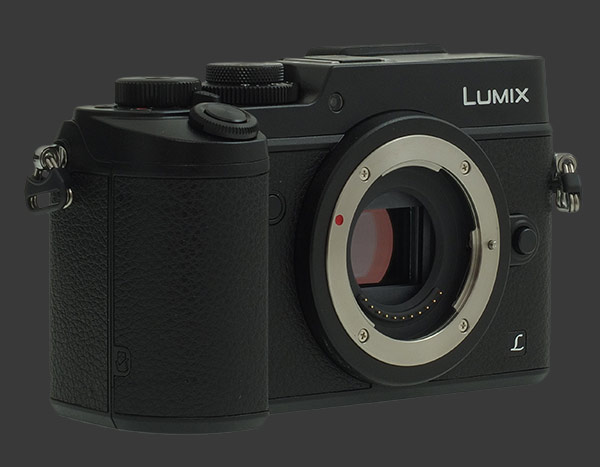
The Panasonic GX8 uses a hybrid shutter which offers mechanical shutter-speeds of 1/8000-60s and electronic ones of 1/16000-1s. Unlike the GX7, the new flagship allows the entire range of ISO sensitivities to be used with either type of shutter. Bulb mode has now been extended to a maximum of 30 minutes, up from 2 which is more versatile and covers most cases of extreme low-light photography. Auto-Exposure Bracketing also offers a class-leading 7-frame bracket. This is usable for Exposure-Fusion or HDR, which this camera can do itself.
While it has full PASM manual controls for both stills and video, the GX8 only offers an Exposure-Priority Live-View in Manual mode. Its white-balance options extensive with Auto, Preset, Kelvin and Custom modes. Every single one of these is fine-tunable in 19 steps along 2 axis which makes the GX8 capable of handling any type of light-source.
Manual-Focus is incredibly easy on this mirrorless. Not only does it have an ultra-high-resolution 2.4 megapixels EVF, it is also equipped with MF Assist and customizable Focus Peaking. This lets photographers precisely see the area in-focus, better than with any type of SLR. It also offers parallel features for exposure: Blinking Highlights and Zebra Patterns.
The superb viewfinder of the GX8 is tiltable while the large 3" touchscreen LCD rotates from a hinge on the left side of the camera. This makes it unwieldy and precarious when shooting at odd angles. The advantage though is that selfies are now possible. There is a standard hot-shoe on this camera, right next to the viewfinder. This lets it support an add-on flash but we suspect the EVF will not be able to tilt with one mounted.
The major improvement over the GX7 is that the new GX8 is weather-sealed, which was the only professional level feature not present on the GX7. As always, a weather-sealed lens is required to make the whole thing usable in adverse weather.
Videographers will be happy to know that this new mirrorless record 4K Ultra-HD video at up to 30 FPS which is recording in standard MPEG-4 format. For HD, 1080p at 60 FPS is possible. This can be stored in MPEG-4 or AVCHD format. The GX8 is capable of producing both Time-Lapse and Stop-Motion videos. The difference being that the former always advances at a fixed pace, while the latter can be stepped manually.
Panasonic Lumix DMC-GX8 Usability - How easy is it to use?
The Panasonic Lumix DMC-GX8 is a boxy camera with a squarish full-height grip. Its design is made mostly of straight lines that curve sharply at corners. The grip provides excellent purchase over the camera and places the shutter-release within comfortable reach of the index finger. The EVF protrudes nicely from the back of the camera which improves comfort.
This mirrorless is relatively chunky and feels quite dense. Every part feels solid, even the rotating display hinge which still shows some flex. It is probably the weakest-link of the GX8, so be careful while the LCD is extended. There are eyelets to accommodate the provided neck-strap which are placed asymmetrically, so that the right one is not in the path of the shutter-release. This is a nice improvement over its predecessor.
There is a nearly invisible button flush with the front surface between the grip and lens mount. Since it is so flat and smooth, it is difficult to locate by feel. This button is unlabeled and customizable to one of 41 functions! These same functions are available for most customizable function buttons described below.
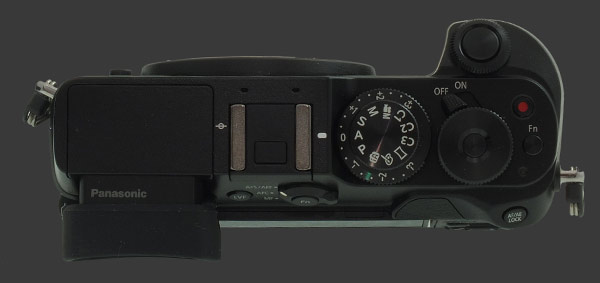
The top plate of the GX8 is packed. The EVF occupies the extreme-left which makes it perfectly comfortable and it can be tilted 90° upwards. To its right, there is a standard hot-shoe behind a stereo microphone. Note the absence of a built-in flash which allows Panasonic to quote better battery-life than otherwise.
There is a wide Exposure-Compensation dial marked ±3 in 1/3 stops. It has nice detents and is unlike to move accidentally. This also makes it immediately clear that EC is set when looking down on the camera. Mounted on top of the EC dial, there is a traditional Exposure-Mode dial with 11 positions:
- All the traditional PASM modes get their own position. P offers Program-Shift.
- Video mode allows recording of video in any PASM mode, as selected in the video menu.
- Three custom modes. C1 and C2 store a single set of parameters while C3 offers 3 memories for parameters.
- Intelligent Auto mode offers automatic operation while letting users specify EC and WB directly.
- The Scene position groups all 24 modes.
- Panorama captures a panorama by sweeping the camera horizontally.
The rear control-dial is tall with marked detents. It has a customizable button in its center which can switch the behavior of both control-dials. Underneath, there is a rotating power-switch. While it has a detent to keep it in place, it is possible to accidentally move it while rotating the rear control-dial.
Two small buttons are found along the right edge of the camera. Both are customizable with the one in front behind marked as the default Video Record button. This is somewhat redundant since the shutter-release can be used to start filming instead. One must enter Video mode for that which is essential anyway since the camera otherwise previews the aspect-ratio of stills.
At the top of the grip, there is a standard two-stage shutter-release with short travel and a soft halfway point to minimize shaking the camera when taking a shot. It is surrounded by the front control-dial which has nice detents too. Neither dial was accidentally turned during the review period, so these detents work well.
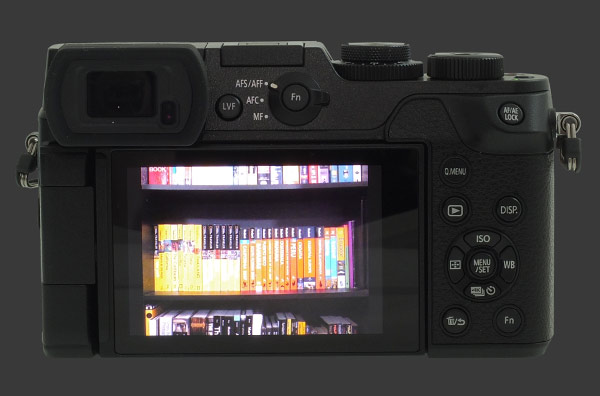
There is a large 3" LCD with 1 megapixels which dominates the back of the GX8. It is attached at the left side of the camera which lets it rotate outwards until it faces the front. From that position it can rotate 335° until it is almost parallel to the bottom of the camera. The display itself is a touchscreen which is not too sensitive and so does not accidentally trigger so often. This can be disabled entirely for safety.
Visibility and viewing angle of the display are very good. The display refreshes quickly and follows motion well. It is unfortunately not Exposure-Priority, except optionally in Manual mode, so exposure is generally not previewed correctly. There is an optional Live-Histogram which is misleading since it is based on the brightness of the display rather than the metered exposure.
What space remains at the rear of the GX8 is extremely busy. The 0.44" EVF shows plenty of details thanks to its 2.4 megapixels. It shows 100% coverage and offers a large 0.77X magnification, which rivals the size of the OVF of full-frame DSLRs. There is an extremely useful Eye-Start Sensor which toggles automatically between the EVF and LCD. Optionally, it also triggers pre-focusing which can be useful for shooting subjects in motion.Just beside the EVF, there is a customizable button. By default it toggles the EVF but, since this is done automatically by the Eye-Start Sensor, it can be assigned to a useful function. Right next to it, there is another customizable button surrounded by a 3-way rotating focus switch. Its options are Single-Shot or Full-Time AF, Continuous AF or MF. The choice between AF-S and AF-F is made by the menu. It is also possible to activate DMF when the switch points to AF-S.
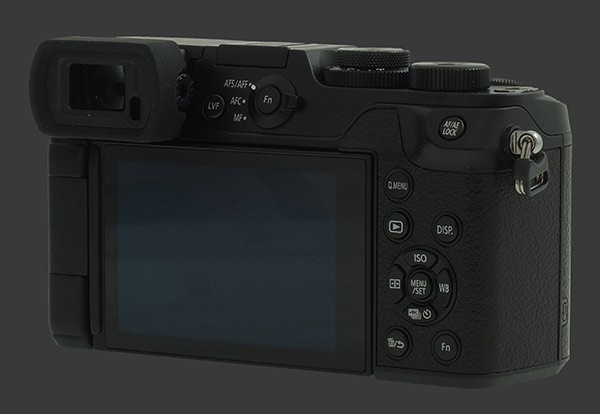
At the upper right corner of the camera is the combined AE-L/AF-L button. This one is customizable to lock exposure, focus, both or act as AF-On instead which simply performs autofocus each time the button is pressed. This can be cancelled by Eye-Start Sensor AF, so leave at most one of these options enabled.
There are buttons arranged as a 4-way controller, including central Menu button, plus 5 extra buttons. The top one and two lower ones are customizable. At the top, the default is to invoke the Quick Menu which offers a menu of icons to change common settings. In an impressive feat of customization, the menu itself is user-configurable.
Still above the 4-way controller, Playback and Disp buttons work as usual. The former toggles between Capture and Playback mode, while the former cycles through various display modes. Each direction of the controller is assigned a function:
- Up: Selects ISO. There are options from 200 to 25600, plus a low 100 when ISO Expansion is enabled and an Auto ISO setting.
- Right: Selects White-Balance. Side directions select a WB setting, including one of four custom memories. Down enters a WB Fine-Tuning and WB Bracketing screen.
- Down: Selects a drive mode: Off, Single-Shot, Continuous, 4K Burst, Bracketing and Self-Timer2s, 10s or 3-frames at 10s. There is no difference between Off and Single-Shot as far as we can tell.
- Left: Selects the AF mode: Pinpoint, Single-Area, Custom Area, Automatic 49-Area, Tracking and Face(Eye)-Detection. The focus point or area, depending on the mode, can be set by pressing Down fro there. Pinpoint allows the selection of an exact point while Single-Area allows the selection of an area with eight sizes are available now!
Two buttons bellow the 4-way controller are customizable too. The left most is used in Playback mode to delete images and to back out of menus.
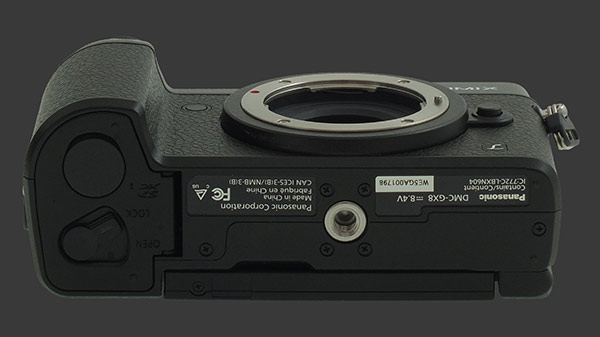
The Panasonic Lumix DMC-GX8 is mostly made of metal and is very sturdy. Even the combined battery and memory-card compartment door appears strong. It certainly feels heavy for its size. At the bottom there is a metal tripod mount directly inline with the optical center of the camera. This is ideal for panoramic photography.
The GX8 has very good ergonomics. Its substantial grip makes it easy to hold securely while controls remain easily reachable. The dual control-dials and buttons for all important settings, plus a grand total of 8 customizable buttons, really make this camera extremely efficient. We are happy to report that the dedicated EC dial greatly improves upon the modal EC control of its predecessor.
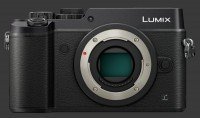 |
Please Support Neocamera
All information on Neocamera is provided free of charge yet running this website is a huge endeavor. Purchases made via affiliate links found throughout the site help keep it running and up-to-date. There is no additional cost to you, so please consider buying via these links to our affilates:
Thank you for your support!
Panasonic DMC-GX8 Highlights

Sensor-Size: 17 x 13mm

Actual size when viewed at 100 DPI
| 20 Megapixels Mirrorless | ISO 100-25600 |
| Micro Four-Thirds Mount 2X FLM | Shutter 1/16000-60s |
| 4-Axis Built-in Stabilization, 3.5-Stop Improvement | Full manual controls, including Manual Focus |
| 0.44" Built-in EVF 2.4 Megapixels (0.77X) | Custom white-balance with 2 axis fine-tuning |
| Automatic Eye-Start sensor | Spot-Metering |
| 2 Axis Digital Level | Hot-Shoe |
| Weatherproof | Stereo audio input |
| Built-in Dust Reduction | Lithium-Ion Battery |
| 8 FPS Drive, Unlimited Images | Secure Digital Extended Capacity |
| 3840x2160 @ 30 FPS Video Recording | |
| 3" LCD 1 Megapixels |
Updates
2025.11.13

Best Gifts for Photographers in 2025 by Budget
The annual Neocamera Photography Gift Guide updated to 2025. Find great gifts for photographers with any price budget.
2025.07.07

Stellar Photo Recovery Review
Review of Stellar Photo Recovery V12. This Windows and MacOS software can recover photos and videos in a huge number of formats from memory cards, USB drives, SSDs and HHDs.
2025.05.14

Huion Kamvas 13 Gen 3 Review
In-Depth review of the Huion Kamvas 13 Gen 3 Pen Display Tablet for photographers and graphic artists.
2025.01.18

Fujifilm GFX 2025 Lens Roundup
Lens Review roundup of Fujifilm GFX Medium-Format lenses. Quality, performance and handling of the GF20-35mm F/4R WR, GF30mm F/3.5 Tilt-Shift and the GF55mm F/1.7.
2024.11.18

Best 2024 Photography Gifts for Every Budget
Great gifts for photographers and photo enthusiasts selected for every budget among the best products of 2024.
2024.08.07

Eye Protection Tips for Professional Photographers
The four main considerations for professional photographers regarding eyewear.
2024.07.14

Fujifilm X100VI Review
Flagship fixed-lens compact digital camera with a 40 MP sensor and Image-Stabilization, a first for the series. Retro design featuring dual control-dials, plus direct ISO, Shutter-Speed and EC dials. Its hybrid viewfinder can switch between EVF and OVF mode.
2024.05.09

Fujifilm GFX100 II Review
Flagship 102 Megapixels Medium-Format Mirrorless Digital Camera with 8-Stop 5-Axis IBIS, 8 FPS Drive, 8K Video and 400 MP Super-Resolution capture in a weatherproof and freezeproof body with dual control-dials and dual memory-card slots.
2024.04.03

Fujifilm X-T5 Review
Newest Fujifilm flagship boasting a 40 MP APS-C sensor, 5-axis IBIS with 7-stop efficiency, 15 FPS continuous drive, 6.2K Video capture, dual control-dials and dual SDXC UHS-II slots in a sturdy weatherproof and freezeproof body.
2023.11.20

Best Digital Cameras of 2023
Find out which are the Best Digital Cameras of 2023. All the new Mirrorless Digital Cameras from entry-level to high-end professional.
2023.07.10

Fujifilm X-H2 Review
40 Megapixels APS-C Hybrid Mirrorless Digital Camera with 7-stop IBIS. Fastest shutter ever and 8K video capture. Large builtin EVF with 0.8X magnification and 5.8 MP, plus an Eye-Start Sensor. Packed with features and large number of controls in a weatherproof and freezeproof body.
2023.05.07

Sony FE 20-70mm F/4G Review
Review of the unique Sony FE 20-70mm F/4G lens. The optical zoom of this lens spans ultra-wide-angle and medium focal-length coverage, making it one of the most versatile Full-Frame lenses on the market.













